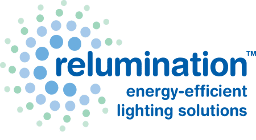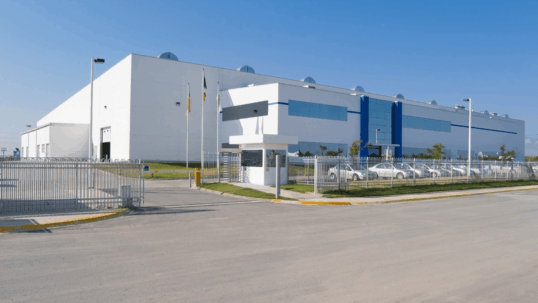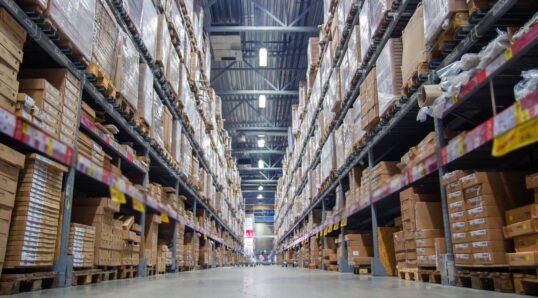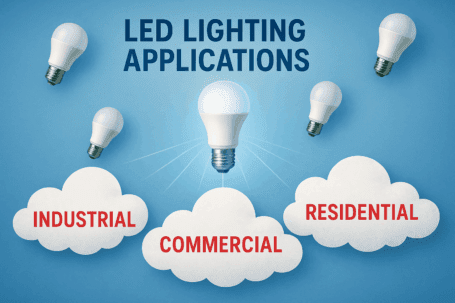Restaurant lighting is the purposeful use of illumination to shape ambience, present food beautifully, guide guests, and keep staff productive while minimizing energy and maintenance costs.
In this guide, we combine insights from multiple articles to cover why restaurants choose LEDs, real‑world case studies, design for ambience and brand, bar and feature lighting, accessibility and wayfinding, energy and maintenance savings, and how Relumination supports retrofits and new openings.
Key takeaways:
- Restaurants are typically lit 16–20 hours daily, so inefficient lamps drive up operating costs; LEDs reduce energy use and cut heat output that would otherwise load your A/C.
- Case studies from Chili’s, Applebee’s, Red Robin, Denny’s, and McDonald’s show dramatic utility savings, longer life, and improved atmosphere.
- Design choices (breakfast‑bright vs. dinner‑dim, themed features, bar accents) plus controls and sensors let you dial in mood and costs together.
- LEDs deliver superior light quality and control, rarely need replacement, and do not emit UV or IR, supporting guest comfort, food presentation, and brand.
Why Chain Restaurants Choose LED Lighting
We are pleased to find that two popular United States chain restaurants have recently decided to retrofit their restaurants with LEDs. LED lamps help improve the appearance of food and highlight decorations around the restaurant. They also save money by consuming less power than other fixtures and can lower the power consumed by the air conditioning because they don’t give off heat. LEDs can also illuminate outdoor signs.
- Chili’s (Brinker International). Chili’s is installing 125,000 LED lamps in the interior and exterior of all 827 corporate restaurants, replacing 30–50 watt lamps with 4.9‑watt LED MR16s and 60‑watt PAR20/PAR30 lamps with 6‑watt LEDs. Brinker calculated $87 per week per restaurant, totaling $3.7 million each year. Appearance and lighting quality have greatly improved with the new LEDs.
- Applebee’s. The chain’s first retrofit (Newtown, PA) kept a similar light level to preserve mood while saving $150,000 in energy costs and reducing CO₂ by 1.8 million pounds. If all 2,000 Applebee’s switched to LEDs, savings would be $1.5 million per month, $18 million per year, and $300 million over lamp life.
- Red Robin. Replaced roughly 12,000 incandescent and halogen lamps with 7‑watt GE LEDs that consume 77% less energy and last six times longer, saving $120,000 annually while delivering “perfect lighting for a restaurant setting.”
- Denny’s. Installed Cree LR6 LED downlights in new and renovated restaurants. Five Colorado Springs locations saved $15,500 annually, with one store using 6,000 kWh less each month. A LEED‑certified Denny’s in Joliet, IL uses LEDs and natural lighting and has reduced energy costs by 83%.
According to the Environmental Protection Agency, restaurants consume more energy per square foot than other commercial buildings and are typically lit 16 – 20 hours daily. With inefficient incandescent and halogen bulbs, that’s a lot of energy. Restaurants, switch to LEDs to save and improve customer experience while helping the environment!
McDonald’s: A Model for Sustainable Design
McDonald’s is making sustainable changes to its restaurants. As a national U.S. Green Building Council member, many McDonald’s restaurants have obtained LEED Gold certifications for their changes. North Carolina’s first green McDonald’s in Cary tore down its old restaurant and built a new sustainable building according to LEED regulations.
McDonald’s uses a combination of Cree LEDs and skylights for its lighting, reducing energy consumption by 78%. Photo sensors ensure appropriate light levels in the dining room and kitchen and are fully automated so employees don’t have to worry about touching the lights. Cree’s LEDs can be found in the dining room, kitchen, bathrooms, hallways, drive‑thru, and parking lot.
Sustainability touches every part of the project: 99% of demolition debris was recycled or reused; counters are made from recycled glass and concrete; low‑flow fixtures cut water use; xeriscape landscaping reduces water usage by 550,000 gallons yearly; the parking lot is paved with recycled concrete and includes hybrid spaces and EV charging; and tables/decor use sunflower seed board, wheat board, kirei board, and bamboo.
Design for Ambience, Brand, and Daypart
Your checklist has so many tasks to complete before your restaurant’s grand opening… Don’t fret. Let’s set the mood with “light.” Restaurant lighting plays a significant role in your venue, and it’s up to you to decide what type of lighting is appropriate for the ambiance and style of your particular business.
Daypart cues. If you are opening a breakfast restaurant, you’ll want bright lighting to establish a wakeful, energetic tone. Restaurants catering to the dinner crowd will want less intense lighting to convey relaxation after a long day. Themed restaurants give you more room to play with fixtures, colors, and placements to convey your theme.
Brand and personality. Part and parcel of being a restaurateur is knowing how to make your restaurant look as good as the food you make. Assess your personality. Ambient lighting is perfect for a small, romantic café, but bright fluorescent‑style lighting suits a large, industrial diner. Both types can be made energy‑efficient. Position your brand accordingly (e.g., the only brick‑oven pizza in town) and don’t ignore small details—even silverware and decor should align with the theme.
Relumination specializes in helping companies reduce energy costs, lower maintenance expenses, decrease environmental footprint, and improve quality of light through energy‑efficient lighting solutions. A true professional design partner incorporates the best lighting solutions right into your redesign.
Bar, Lounge, and Experience Lighting
You can make your restaurant environment better by creating a fantastic atmosphere. LED lighting can be used to improve your restaurant during the holiday season or whenever you want to create an ambience your customers will not forget.
- Liquor shelf. A bottle shelf with color‑changing lights attracts attention; light reflecting off bottles creates a focal point.
- Bar tops/bottoms. Use LEDs on the bottom of the bar and at the top; dim the house lights and let bar lighting set the mood.
- Dance floor. If you have a dance floor, use LED lighting on the floor; different lights matched to the beat add a fun atmosphere that boosts guest happiness.
LED lighting lets you add an incredible touch to your restaurant, bar, or club.
Table, Entrance, and Outdoor Lighting
A restaurant cannot solely rely on the quality of the food. Excellent lighting can create a desired ambiance and help your restaurant succeed.
- Provide just enough table lighting. Excessive lighting can make an eating space look clinical. Create a calm, relaxing atmosphere with properly placed fixtures, correct color temperature, and accents that enhance illumination.
- Make an appealing entrance. Whether candlelit dinner or welcoming family feel, entrance lighting sets expectations—carry that plan throughout to create a cohesive experience.
- Sufficient outdoor lighting. Light the outside entrance and any outdoor seating so people feel safe when choosing—and using—your space. It can be challenging to perfect an exterior plan, but professionals can devise the right solution.
Accessibility and Wayfinding (ADA and Beyond)
Accessibility means visibility. When people think about ADA compliance and accessibility issues, they often think of wheelchair ramps. It’s also essential to have the proper lighting so customers with visual impairments are comfortable, and to add signage that enhances the experience for everyone.
- Light the sides of ramps and main aisles. Tape wears out and gets obscured by dim lighting. Smooth, continuous lighting along edges highlights paths, keeps traffic flowing, and reminds patrons to keep bags out of the aisle.
- Multiple lit signs to restrooms and exits. Split floor plans need ceiling‑high, well‑lit signs and redundant directional arrows wherever the doorway is obscured. Many Applebee’s hang neon signs with arrows on opposite sides—helpful and on‑brand.
Energy, Maintenance, and Light Quality
Many restaurants find that their energy bill can be exceedingly high, especially at locations open 24/7. Although keeping the business well lit is a necessity, the high cost isn’t. Our LED lighting approach has a number of advantages for restaurant lighting:
- LED lighting rarely needs replacement. Nothing is more of a hassle than replacing incandescent or fluorescent bulbs during service. You could go 20 years without having to change an LED light bulb. A typical incandescent lasts about 750 hours; a Geobulb lasts 30,000 hours. Solid‑state lights are more stable than incandescent or fluorescent bulbs.
- Superior light quality and control. Typical lighting can be harsh and irritating, often leading to headaches and stress in workers. An LED does not emit ultraviolet or infrared light. LED lights also have extensive brightness/dimness control, allowing adjustment across intensity without a change in color temperature.
- Energy Star solutions. In a typical restaurant, the lights remain on 16–20 hours per day. Energy Star‑endorsed fixtures and bulbs reduce energy consumption, cut heat output by up to 75%, and last 10–25× longer than standard lighting.
Take the time to contact us at Relumination if you have questions about the benefits of installing LED restaurant lighting.
Exterior Signs and Parking
LEDs can illuminate outdoor signs and bring your brand to life with high efficiency and long life. Many chains have extended LEDs to parking lots and drive‑thrus, pairing skylights and photo sensors with LED fixtures so light levels stay appropriate while cutting waste.
How Relumination Helps (Retrofits & New Builds)
From grand opening to chain‑wide retrofit, Relumination helps you:
- Audit and design for your brand and dayparts, specifying CCT/CRI, beam spreads, and control profiles that make food look fresh and appetizing while keeping kitchen/service areas safe and bright.
- Engineer energy savings with LED fixtures, photo sensors, and occupancy/daylight controls that reduce consumption and A/C loads (because LEDs don’t give off heat).
- Implement with minimal disruption, then train your team on controls and dimming scenes for breakfast, lunch, dinner, late‑night, and special events.
- Leverage rebates and incentives to accelerate ROI; many projects pay back quickly through lower utility and maintenance costs.
Relumination, LLC specializes in helping companies of all sizes reduce energy costs, lower maintenance expenses, decrease their environmental footprint, and improve their quality of light through energy‑efficient lighting solutions.
Conclusion
Restaurant lighting is both art and operations—it shapes ambience, guides guests, and keeps teams productive while cutting costs. Real‑world projects from Chili’s, Applebee’s, Red Robin, Denny’s, and McDonald’s demonstrate how LEDs improve appearance, reduce energy and A/C use, extend lamp life, and enhance mood.
Whether you’re tuning table light levels, lighting ramps and restrooms for accessibility, or turning your bar and dance floor into a share‑worthy feature, LED lighting gives you the control and quality you need—and pays for itself through energy and maintenance savings.
Contact Relumination to plan your retrofit or new‑build lighting. We’ll help you set the mood, lower the bill, and elevate the experience with a smart LED lighting design tailored to your restaurant.





